

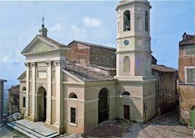
Archeological examination of the current structure suggests that it was probably established soon after the inhabitants returned to the site of the Umbrian settlement in the 7th century. (For the historical background, see the page on the history of Otricoli).
The presbytery and the crypt below it seem to date to a 9th century remodelling, but the rest of the structure seems to have been rebuilt in the 12th century.
The earliest surviving documentary reference to the church dates to 1148, when it was administered by a community of Augustinian canons.
Cardinal Bernardino Lopez commissioned the building of an atrium in front of the original facade in ca. 1500, and his arms can be seen in its vaults. The renaissance campanile had to be demolished and rebuilt in 1839, and the present neo-Classical facade was added in front of the atrium in 1840.
[Details of original facade inside the atrium and of the portal]
Interior
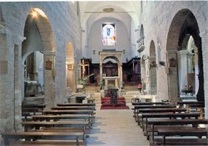
The walls pierced by arches that now separate the nave from the aisles replaced two colonnades that used ancient columns. One of these columns is embedded in a pilaster on the left of the aisle (in the foreground of the illustration above). Other remains from the colonnades can now be seen in the crypt.
Cardinal Bernardino Lopez commissioned the vaulting of the nave in ca. 1500, and his arms can be seen in the vault at the centre.
Cappella di San Fulgenzio
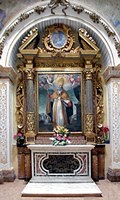
The altarpiece (17th century) depicts St Fulgentius: two churches in the background, to the left, probably represent San Fulgenzio and San Vittore, both of which are in nearby Ocriculum.
The polychrome wooden statue (12th century) of the Madonna and Child enthroned on the right is in Byzantine style.
Cappella della Madonna della Misericordia
This chapel is to the right of the presbytery.
Its present altarpiece (13th century) of the Madonna and Child, which is attributed to Simeone and Machilone. This was stolen from the church in 1978 but subsequently recovered, and has recently been restored.
The earlier altarpiece (16th century), which depicted the Madonna della Misericordia with SS Antony Abbot and Antony of Padua, was by Jacopo Siculo. This was subsequently transformed into a Madonna del Rosario by the addition of two angels who crown the Virgin with roses. [Where is it now??].
Presbytery
The marble high altar (12th or 13th century) now stands under a ciborium (16th century). [Describe the altar]
The window at the foot of the altar allows worshippers to see the re-used Roman sarcophagus in the crypt below that contains the relics of St Victor and other martyrs. They were translated here from San Vittore in Ocriculum in 1351.
Two important inscriptions embedded in the left wall came originally from the cult sites at Ocriculum and relate to the relics of the saints of Otricoli:
-

-
✴an inscription (late 6th or 7th century) that was brought here from San Vittore in Ocriculum in 1351, which celebrates St Fulgentius' discovery of the relics of St Victor
-
IVBANTE DEO FVLGENTIVS EPISCOPVS INVENTO CORPORE
-
MARTYRIS VICTORIS IN XR(IST)I NOMINE SVPER ALTARE CONSTRVXIT
-

-
✴an inscription (late 6th century) that was brought here from San Vittore in Ocriculum in 1316, which identified the relics of St Fulgentius and other martyrs, including St Corona:
-
Hic requiescunt s(an)cti Fulgentius
-
Lozimus Nectarius Leopardus et Corona martyres C(h)r(ist)i....
On the right of the presbytery, there is a lovely Renaissance tabernacle for the host, below the matrons' gallery.
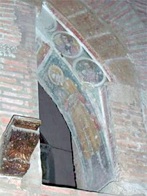
Cappella di Sant’ Antonio Abate
This chapel (to the left of the presbytery) was originally dedicated to St Fulgentius and contained his relics and those of S Lozimus Nectarius Leopardus and Corona from 1316, when they were translated here from San Vittore in Ocriculum until the 1670s:
-
✴The relics of St Fulgentius were translated to the new Cappella di San Fulgenzio (above) in 1672.
-
✴The relics of SS Lozimus Nectarius Leopardus and Corona were placed in a in a small Roman sarcophagus (2nd century AD) and translated to:
-
•new Cappella di San Fulgenzio, in 1672; and then
-
•the Cappella della Madonna del Rosario (below), in 1730.
Cappella della Madonna del Rosario
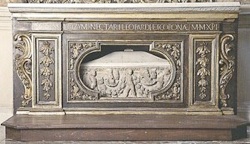
This chapel (the 2nd on the left) contains the relics of SS Lozimus Nectarius Leopardus and Corona under the altar. As noted above, they were translated here in 1730.
Cappella della Santissimo Sacramento
This chapel (the 1st on the left) is a smaller copy of the chapel with the same dedication in St Peter's, Rome. The frescoes (17th century) in the cupola of an Allegory of Prayer are from a cartoon by Pietro da Cortona.
The fresco (late 15th century) of St Bernardino of Siena to the right of the entrance to the chapel is by a follower of Pier Matteo d' Amelia.
Counter-façade
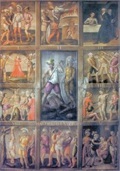
-
✴scenes of the tortures inflicted on St Victor (scenes I - IX);
-
✴the martyrdom of St Corona (scene X); and
-
✴the beheading of St Victor (centre).
Cripta di San Medico (1613)
Steps on either side of the nave lead down to the annular crypt, which was remodelled in 1613 to accommodate the relics of of St Medicus and other martrys. The remains of the original semi-circular apse can still be seen in the floor in front of the altar.
The above relics had probably been discovered in the ca. 1000 under the tribune of San Vittore (the date of the identifying inscription, below). They were rediscovered in 1611 and translated to Santa Maria Assunta in the following year. They are now under the baroque altar of the crypt.
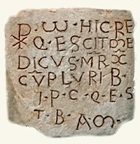
HIC REU(VI)ESCIT MEDICUS M(A)R(TIR) X(RISTI) CV(M) PLVRIB(VS) I(N) P(A)C(E) Q(VI)ES(CEN)T(I)B(VS) AM(EN)
The corridor [at the back of the crypt ?] leads to the reliquary of St Victor and the other martyrs, which is also visible from the window under the high altar.
Read more:
L. Catalano, “Santa Maria Assunta a Otricoli: il Contesto Monumentale e l’ Attività di Cantiere” (2011-2)
Return to the page on: Monuments of Otricoli; or Walk around Otricoli

